There may be no better example of an heirloom recipe than Sunday Sauce. That quintessential blend of tomatoes, onion, and garlic, slow simmered low and long with a magical blend of Italian seasonings until it transforms into a thick, rich gravy. Served over pasta with sausage and meatballs, it makes a practically perfect meal. Don’t forget the vino – for you and the sauce!
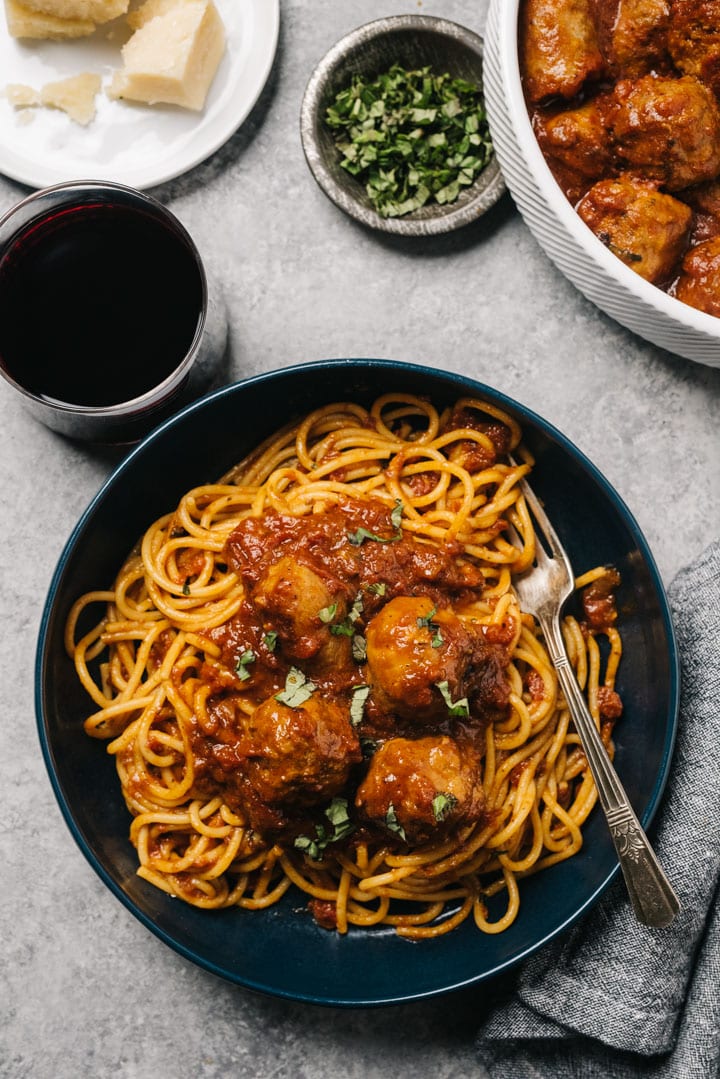
Jump to:
- What is Sunday Sauce?
- Sauce…or Gravy? What’s the Difference?
- So, It’s Not All Just Marinara?
- How to Make Sunday Sauce
- Do I Need to Crush the Tomatoes by Hand?
- What Kind of Meat Should I Use?
- Chef’s Tips
- What Does it Mean to “Sweat” Onions?
- How Long Should I Cook Sunday Sauce?
- What Kind of Pasta Should I Use?
- What Kind of Pot Should I Use?
- Okay, What’s a Heat Spreader?
- Can I Cook Sunday Gravy in a Slow Cooker?
- More Classic Italian American Recipes
- Recipe
Picture it: Jersey. 1992. Tarantella Napoletana playing on the radio. A candle in a basketed chianti bottle flickers atop a red and white gingham tablecloth, while a girl stands at the stove with her nonna, learning the secrets of their traditional sauce recipe…
Yeah. Literally none of that happened.
First of all, there was a family recipe, but my grandmother held on to its secrets with the same iron grip she used to hold her wooden spoon – both for stirring said sauce and occasional thwacks for misbehaving grandchildren. I didn’t know her secret ingredient was the tiniest pinch of cinnamon until I was in my 30’s and well into making my own versions of her sauce.
Second, Sunday Sauce as we know it is an inherently Italian-American thing, so its not like her recipe came directly from the “old country” either. (And I have news for you, your grandmother’s sauce also is not “the OG.”) Further, Grandma – actually Babcia – is Polish. But she loved her husband and her (truly OG) mother-in-law so much that she spent 50 years perfectly their version of Italian American Sunday Gravy. So.
But this is all kind of the point, and totally in the spirt of Sunday gravy making. Sauce is always going to change with the times (literally and figuratively)- what’s available the day before at the market, what meat you can afford, if you can afford any meat, what wine you have on hand, whether you have the gumption to make meatballs, etc. We pick up tips and tricks from our families; we carry on traditions; but the roots are the same.
So, if you don’t have your own “roots,” please, feel free to use mine to grow your own Sunday Sauce. I promise the time it takes is worth every bite and every memory.
What is Sunday Sauce?
Sunday Sauce isn’t just a sauce. (And I don’t mean that in the sense that you could literally eat a bowl of it as a meal on its own.) Sunday Sauce is a whole thing. It can also be the centerpiece around which lots of other things happen. But regardless, it’s an event, in and of itself. A full-day, sun-up to sun-down process. A marathon, not a sprint.
Maybe your family is bustling around you while it simmers, maybe you’re alone. Maybe you’re cooking other dishes and baking treats all day, maybe you’re being lazy on the couch and just checking it periodically. That’s the beauty of the Sunday Sauce. The person cooking the Sunday Sauce gets to dictate the parameters.
That being said, Sunday Sauce is, in fact, also a sauce. If you need to qualify it more, it’s pasta sauce (though it certainly can be eaten without pasta and with other things – try it over polenta).
Sunday sauce is tomato-based and simmered long and slow until it could conceivably thicken back into the paste from whence it came. Thicker than stew. Way thicker than an Italian Meat Sauce. In fact, despite possible naming right violations, I prefer it thicker than gravy. Deep, deep, deep murder red in hue, and when I say chunky, I mean chunky – this is not pizza sauce.
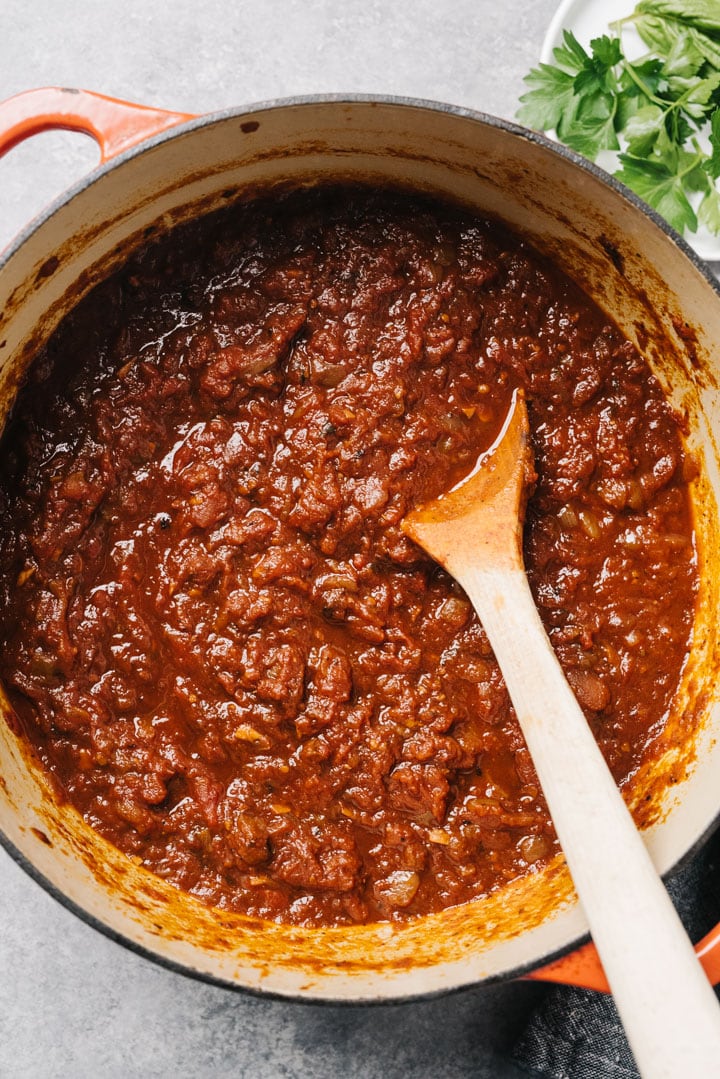
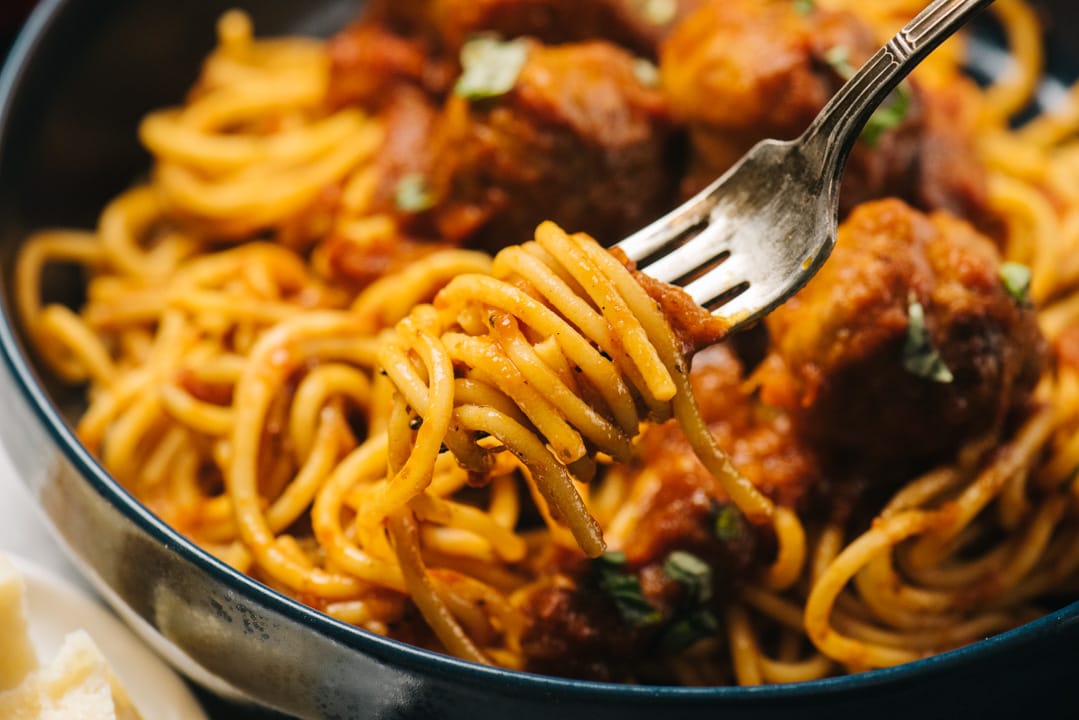
Sauce…or Gravy? What’s the Difference?
So the only people I know who quibble about this were raised in either a sauce house or a gravy house and then married someone from another camp. (Like 20th century Capulets and Montagues.) Most people have their family word for it and stick with it and pass it on to their kids.
Some people say it has to do with the region they’re from, some say it’s age or when their family emigrated, some say it depends on how many times you’ve watched the Sopranos. But there’s no real pattern of distinction. And to be clear, there is no substantive difference between Sunday Sauce and Sunday Gravy.
So, It’s Not All Just Marinara?
Forget the semantics of sauce vs. gravy, and hold on to your hats for the lesson you never knew you needed. All marinara is tomato sauce, but not all tomato sauce is marinara. Plenty of Italian sauces have tomatoes, but not all will have a tomato base. Capisce? Here’s a quick primer:
- Marinara is straight-up vegetarian tomato sauce – no meat, often no dairy, slightly watery. You can make it with fresh tomatoes or canned. Try our fresh tomato marinara sauce, or our vegan marinara sauce.
- Pomodoro basically has the same base as Marinara, but cooked longer and blended to a thicker, smoother consistency.
- Add cream and vodka to your pomodoro and it becomes vodka sauce; add hot pepper to your marinara, and you’ve got arrabiata.
- There are several types of ragù, which is a meat-based sauce that may, or may not, include tomato. The most famous ragùs are Napoletana (flavored with red wine) and Bolognese (flavored with white). Try our Instant Pot Beef Ragu, or Pulled Pork Ragu (it’s made using leftover pulled pork, so it’s super quick).
- You might have also heard of Amatriciana, which is a tomato sauce that includes very specific (like on a national register) meat (pork jowl) and dairy (romano cheese). Italians can be…picky.
- Plus, there are plenty of sauces that traditionally include tomatoes, but not as the base: Puttanesca, Norma, Primavera.
How to Make Sunday Sauce
Sunday sauce is an essential Italian staple. It’s cooked long and slow, resulting in a robust flavor and thick texture. I serve it over spaghetti or bucatini pasta with homemade meatballs. NOTE: This recipe requires a minimum of 5 hours including prep time and up to 10. It’s best to start first thing in the morning.

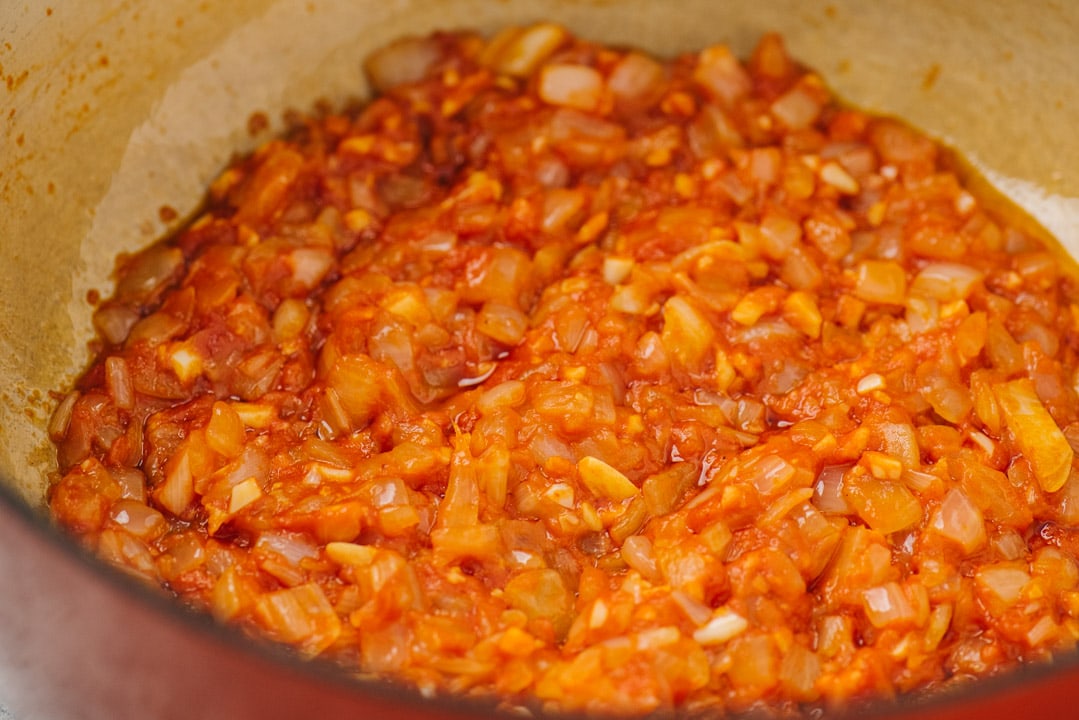
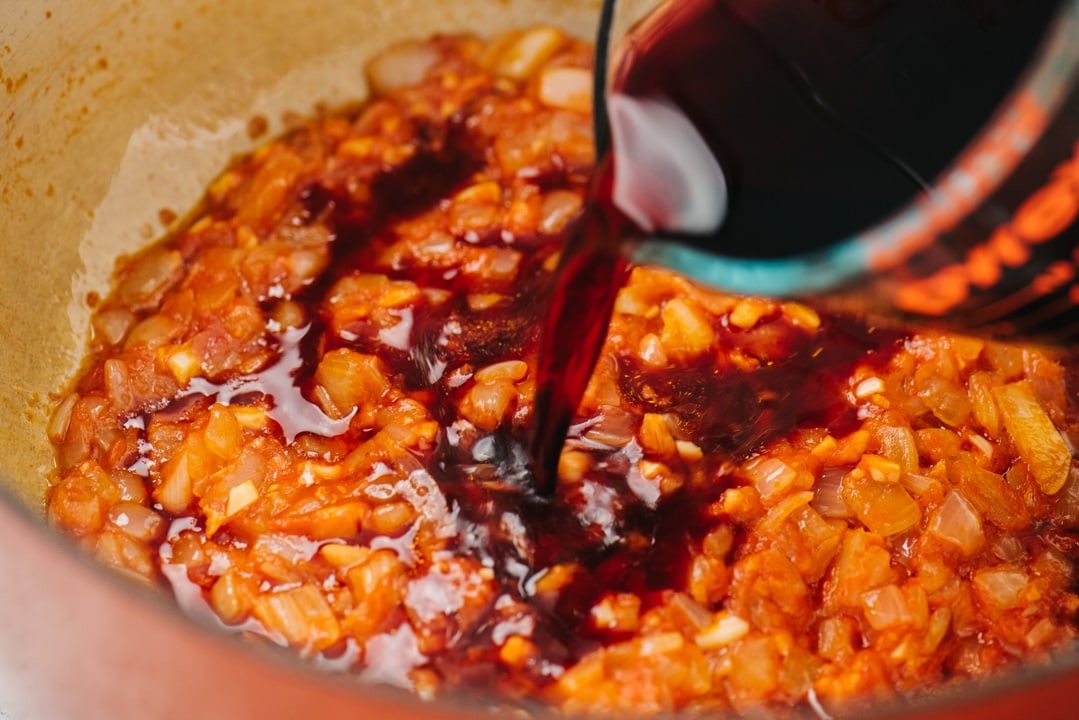
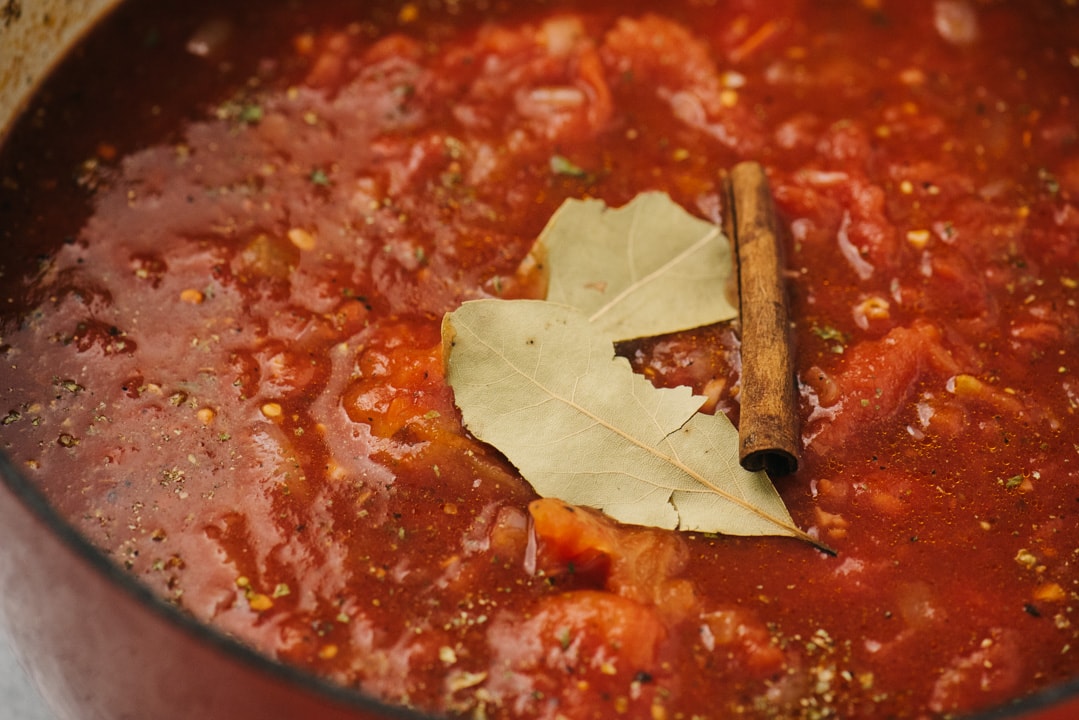
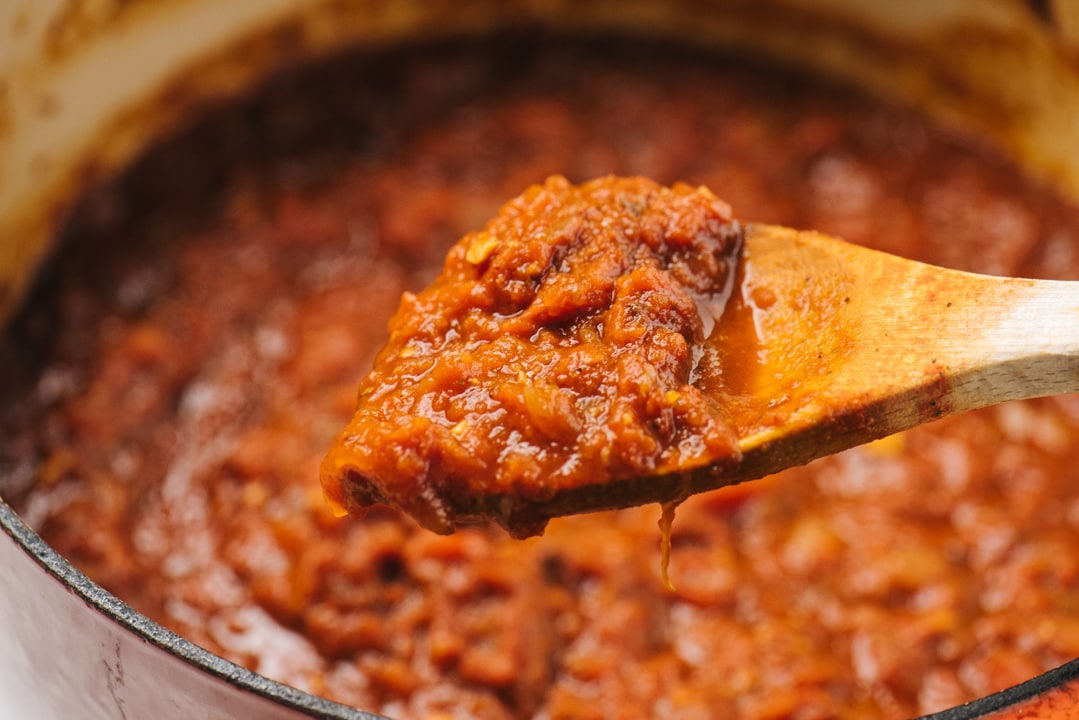
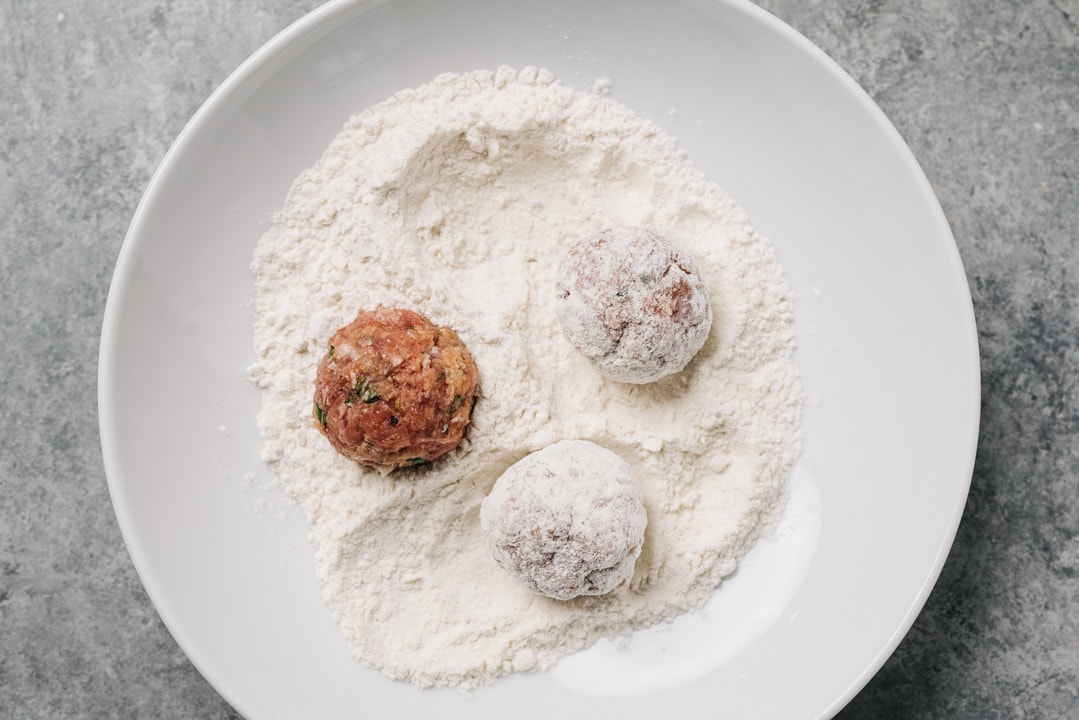
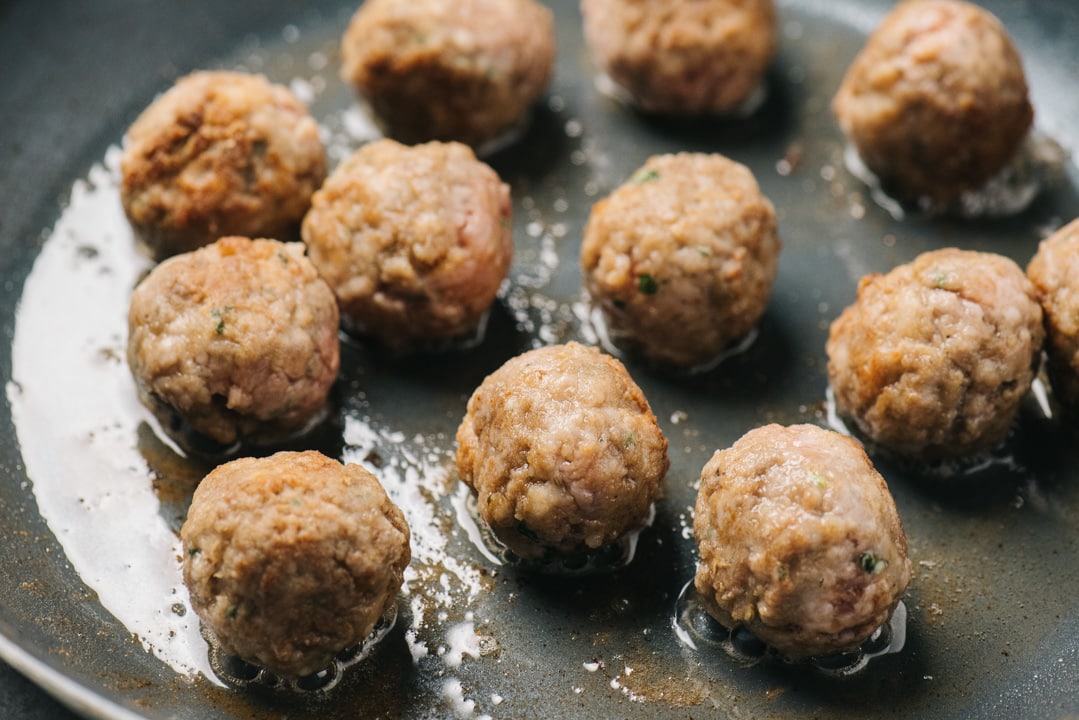

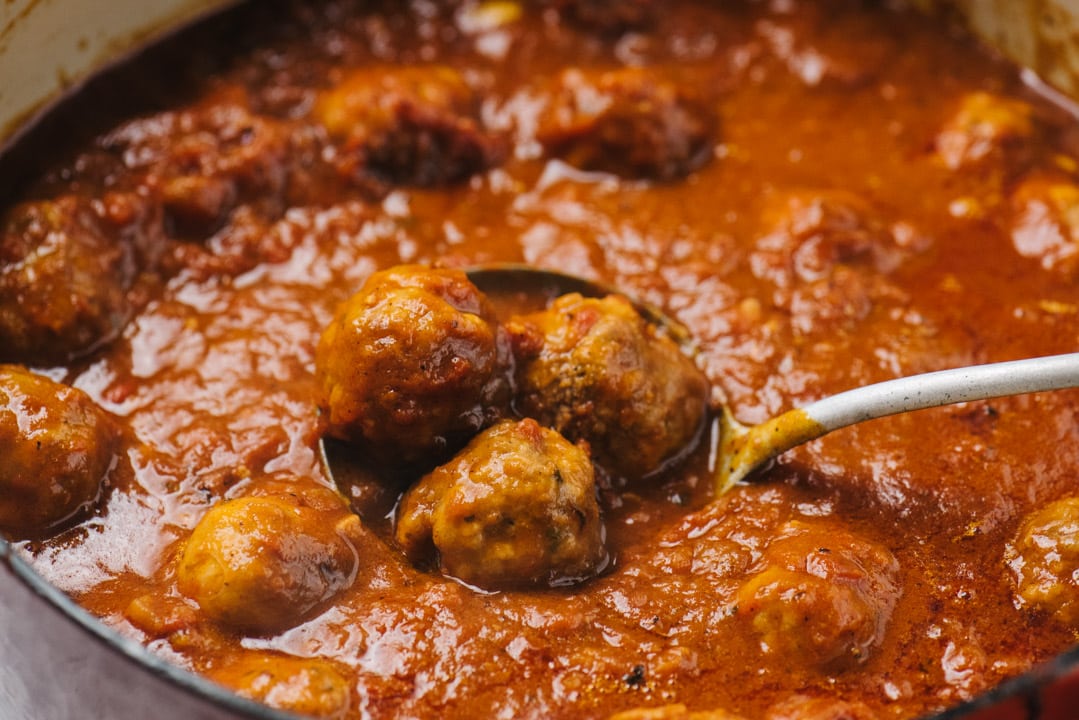
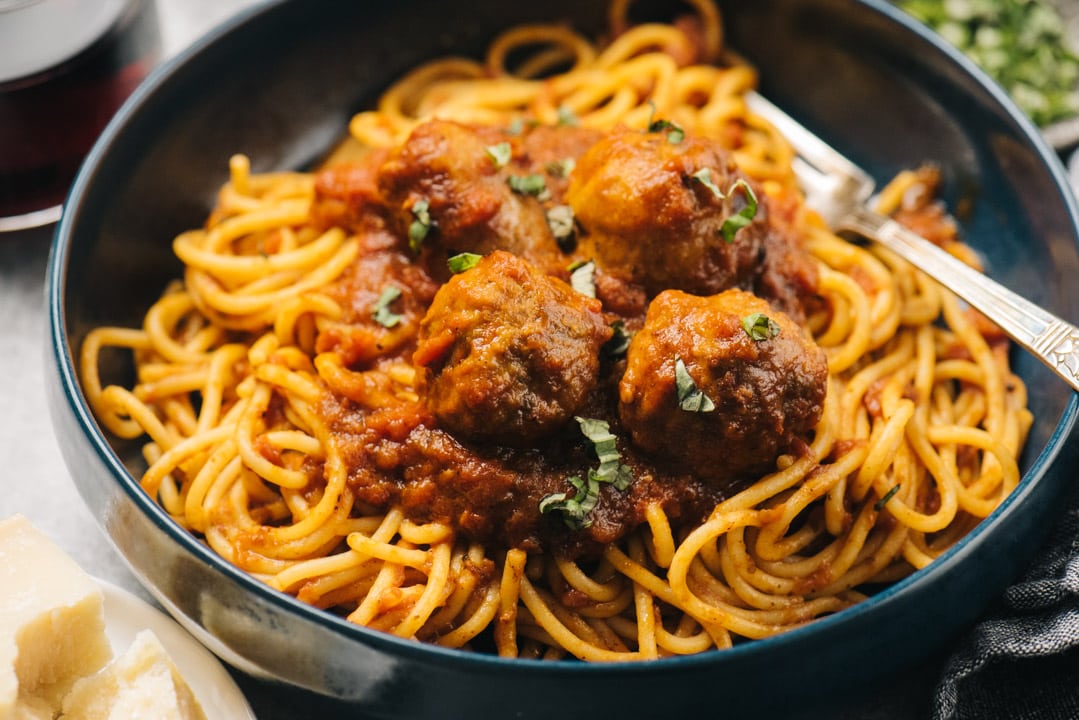
- In a dutch oven, sweat the onions in butter over medium heat.
- Add the garlic and cook 1 minute more. Add the tomato paste and cook, stirring frequently, to work into the onions and cook off the canned flavor.
- Deglaze the pot with red wine and cook until the wine stops bubbling and is reduced by about a third.
- Add hand crushed tomatoes, salt, pepper, dried herbs, red pepper flakes, a cinnamon stick and a bay leaf. Give everything a good stir.
- Simmer over low heat for 6-8 hours, until the sauce is deep burgundy and the tomatoes are falling apart. Stir every hour to prevent scaling, and when you do so, gently crush the tomatoes with the back of a wood spoon.
- Mix the meatballs and form into heaping tablespoon portions. Roll in flour.
- In batches, sear the meatballs in olive oil until browned on all sides.
- Sear the the sausages until browned on two sides.
- Add the meatballs and sausages to the sauce; simmer 45 minutes, until cooked through.
- Toss one pound of pasta with two cups of sauce; portion into pasta bowls, top with more sauce, meatballs, and sausage, and serve right away.
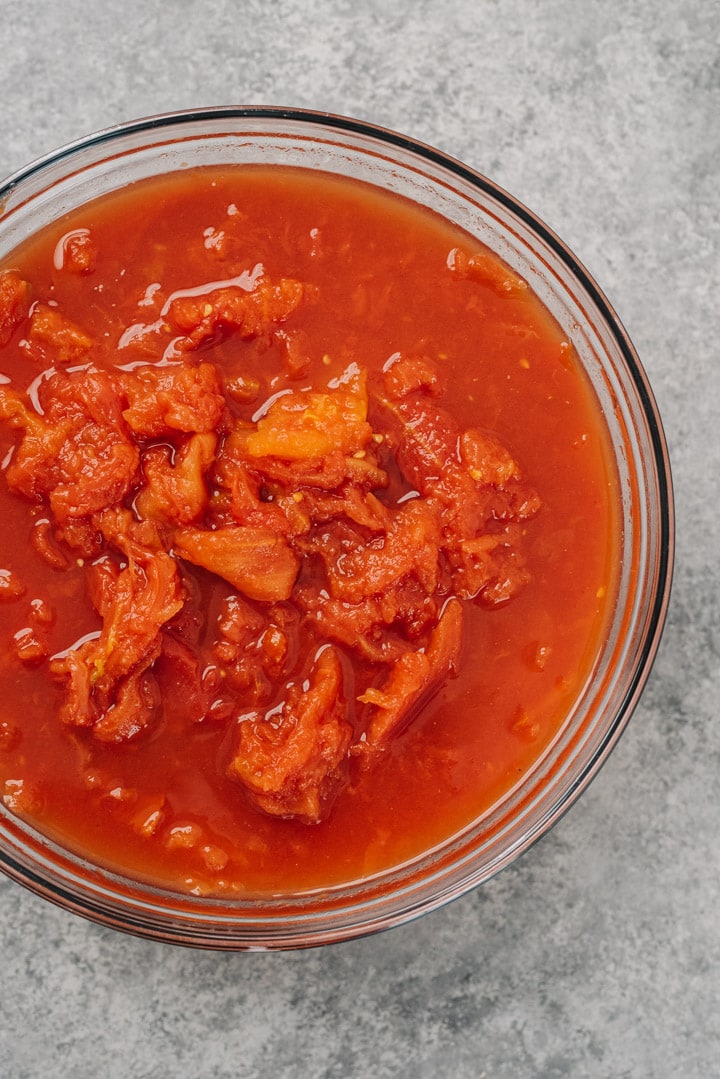
Do I Need to Crush the Tomatoes by Hand?
*ahem* (I’m channeling the spirits of the many Italian women who came before me): “You don’t need to do anything. You could do that, but you don’t have to. I think it tastes better but if you don’t want to listen to me, go ahead, break my heart. Just go to the store and buy sauce in a jar, why don’t you?”
In all seriousness, it’s all simply a matter of (1) tradition and (2) texture. I’ve always used whole. They serve as a good visual gauge for progress – when they’ve fallen apart or disintegrated, you’re there. If you cook it as long as Italians and nature intended, everything in the pot becomes one with the sauce anyway.
TIP: I’ve found that freshly canned tomatoes take closer to 4-5 hours, whereas commercially purchased canned tomatoes can take 7 or more.

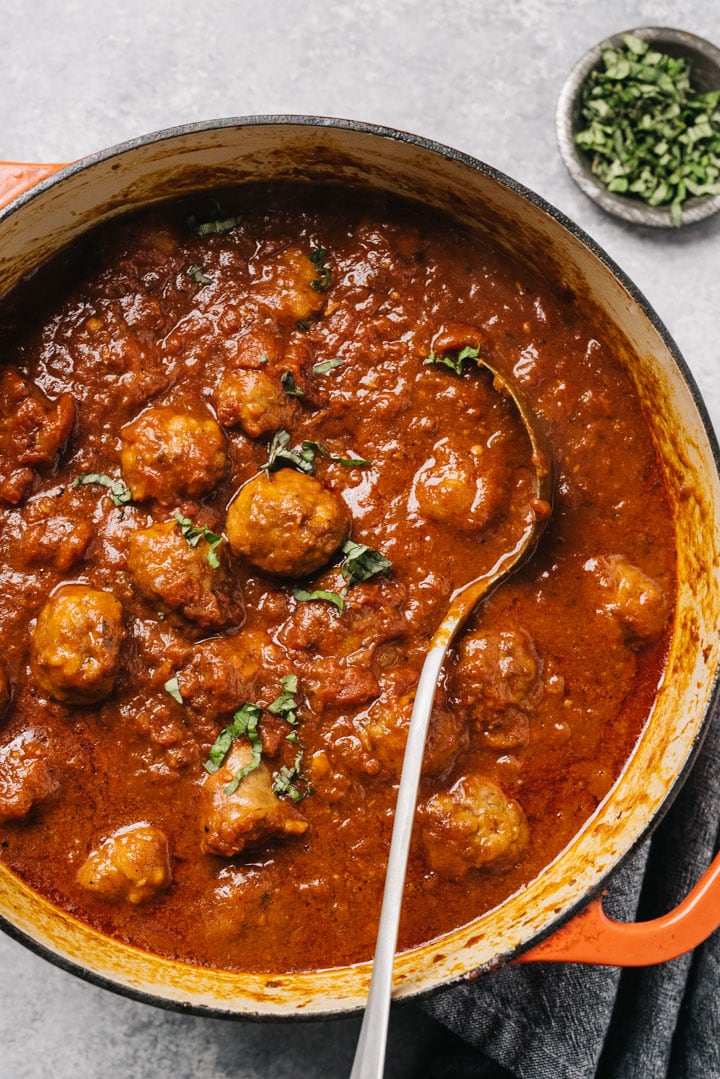
What Kind of Meat Should I Use?
This recipe calls for sausage and meatballs for eating purposes, not slow simmered purposes. You’re going to add them toward the end. If you have a vegetarian at the table, I recommend scooping out a serving or two before simmering the meat.
If you want a meatier sauce, you can absolutely treat this recipe as a base, and add meat to the cooking process. Use whole cuts of meat, not ground (that’s a different recipe, like I say, Italians are picky!):
- Beef, pork, and veal are all safe bets. You don’t need prime rib; pre-cut stew meat works great in sauce and breaks down easily. Hell, throw in an oxtail if you’re feeling frisky! Literally any meat in the “use by TODAY” section of the grocery store will work.
- Some people swear by bone-in meats to add more flavor and richness (and marrow! – we like short ribs!) – just watch out for fragments! You will absolutely wind up with them once the meat completely breaks down.
- Bone-in or out, for the love of good flavor, always sear your meat first.
- You can absolutely add sausage or meatballs to the sauce in the beginning, but rest assured, you will not have sausage or meatballs by the end of the process. Just a lot of ground meat. Which is also delicious.
How to Add Meat to Sunday Sauce
- Pick your meat. Divide into 3-4″ chunks for larger cuts.
- Pat the meat dry, season with salt and pepper, then sear in olive oil until well-crusted on at least 2 sides. For ground meat, simply saute until no longer pink.
- Remove the meat and set aside. Make the sauce as written through step 5, then add the meat to the pot before simmering in step 6.
Chef’s Tips
- Use best quality whole canned tomatoes. We like Muir Glen.
- Tomatoes need a lot of salt! Start with 2 teaspoons and taste frequently.
- Herb Rules: dried herbs are added before simmering; fresh herbs are stirred in at the end.
- Sweat the onions, don’t sauté (see below for more).
- Cook it low and slow. Then cook it a little bit longer. The finished sauce should be deep red in color with a muddy consistency.
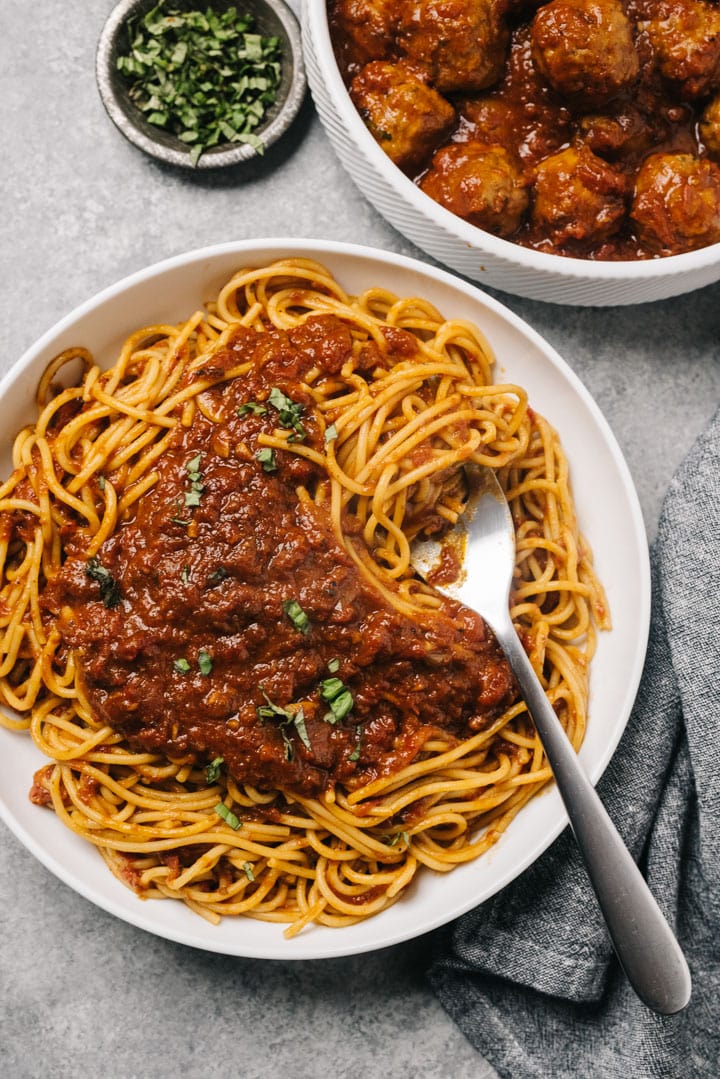
What Does it Mean to “Sweat” Onions?
To cook them until all the water evaporates, but the onions don’t brown. You’ll know they’re fully “sweated” once there is no water content left in the pot – the onions will be transparent and with just a thin layer of fat (in this case butter) visible. Sweating imparts the flavor of onions without their naturally sweet sugars developing.
How Long Should I Cook Sunday Sauce?
At least 6 hours, and up to 10. The sauce is ready when it’s very deep red in color and the tomatoes are falling apart. The sauce will appear “muddy” and be very thick.
What Kind of Pasta Should I Use?
Any and all pasta is fair game, but I swear by good old spaghetti or bucatini. Long and thing ensure lots of sauce coverage. But do, please, use whatever you love! We love Sunday Sauce with gnocchi.
What Kind of Pot Should I Use?
You’re going to need a heavy bottomed pot that retains heat well. I use my trusty dutch oven. You may also want to use a heat spreader to prevent scorching if your gas stove is temperamental. It’s not a necessity, but it makes a difference considering the extensive cooking time.
Okay, What’s a Heat Spreader?
A flat cooking element that can be positioned over a burner to aid the cooking process by controlling heat distribution. It works on gas and electric stoves.
Can I Cook Sunday Gravy in a Slow Cooker?
Yes, you can can, but for best flavor you’ll need to do the heavy lifting outside the slow cooker. You’ll should definitely pre-crush the tomatoes before using. Canned crushed tomatoes will yield a smoother sauce, while hand-crushed tomatoes will create a chunkier sauce.
- Prepare the base through step 4 (prepare the tomatoes, sweat the onions, add the garlic and tomato paste, and deglaze the pan).
- After deglazing, scrape the onion mixture into your slow cooker, then add the remaining ingredients (hand-crushed tomatoes, salt, pepper, dried herbs, red pepper and cinnamon stick). Give everything a good stir. Slow cook on LOW for 6-8 hours, stirring occasionally.
- If you’re adding meatballs and sausage, add them at the four-hour mark. If you’re adding seared cuts of beef or pork, add them now, before starting the slow cooking process.
More Classic Italian American Recipes
- Healthy Italian Sausage and Peppers
- Beans and Greens on Garlic Toast
- Health(ier) Italian Meatballs
- Italian Basil Chicken with Creamy Pan Sauce
- Instant Pot Italian Pot Roast
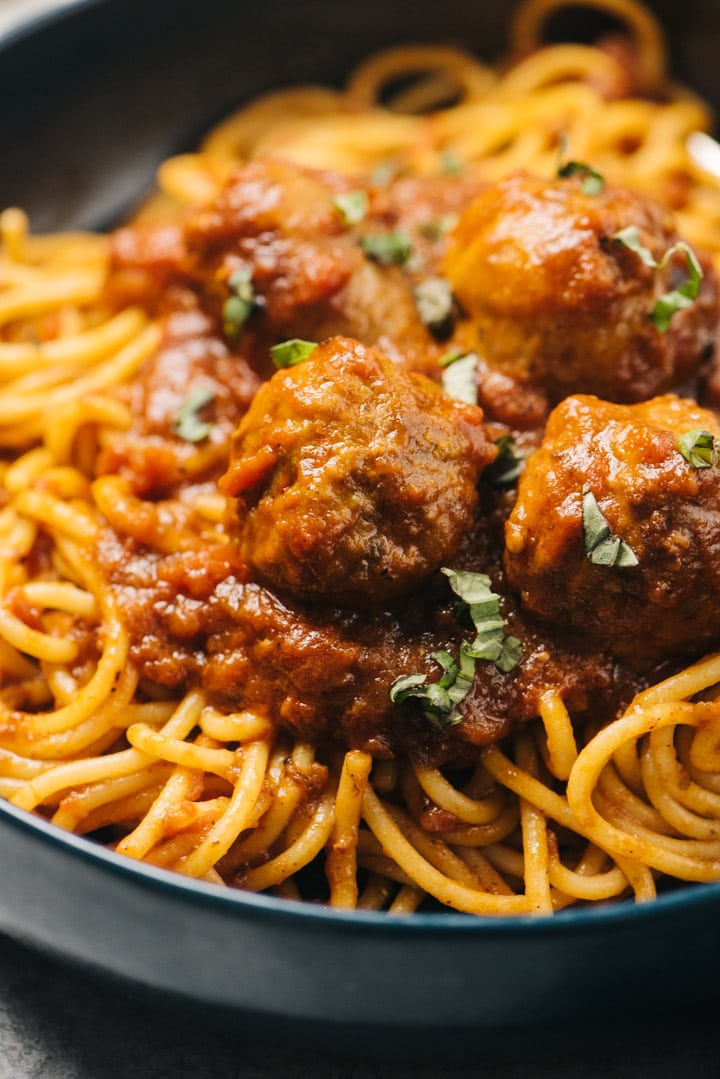
Did you make this Sunday Sauce with Homemade Meatballs? I’d love to know how it turned out! Leave a comment and a rating below.
While you’re at it, let’s be friends – follow me on Pinterest and Instagram for the latest and greatest.
Recipe
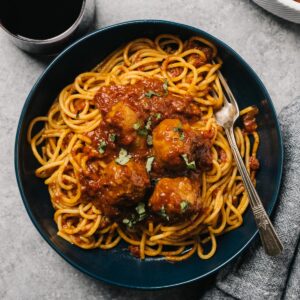
Sunday Sauce with Homemade Meatballs
Print Recipe Rate this Recipe Pin RecipeRecommended Equipment
- Heat Diffuser
- Large Skillet
- Large Stockpot
Ingredients
Sunday Sauce
- 3 28-oz cans whole canned tomatoes, hand crushed
- 4 tablespoon butter
- 2 large sweet onions, finely chopped to ¼" dice
- 6 cloves garlic, minced
- 3 tablespoon tomato paste
- 1 cup dry red wine
- 2 teaspoon kosher salt
- 1 teaspoon fresh cracked pepper
- 1 teaspoon dried basil
- ½ teaspoon dried parsley
- ½ teaspoon dried oregano
- ¼ teaspoon red pepper flakes, optional
- 1 cinnamon stick
- 2 bay leaves
- fresh chopped basil, for serving
Pasta
- 8 c water
- 2 tablespoon or more kosher salt
- 1 lb pasta, we prefer bucatini or spaghetti
- freshly shaved parmesan cheese, optional, to taste
- ricotta cheese, optional, to taste
Meatballs and Sausage
- 1 lb ground beef
- 1 lb ground pork
- 2 large eggs
- 1 teaspoon garlic powder
- 1 teaspoon onion powder
- 1 tablespoon fresh parsley, minced
- 1 tablespoon fresh basil, minced
- 1 teaspoon kosher salt
- 1 teaspoon ground pepper
- ¾ cup unseasoned breadcrumbs
- ⅓ cup all purpose flour
- 4 tablespoon olive oil, divided
- 1 lb italian sausage links, sweet or hot
Instructions
For the Sunday Sauce.
- Crush the tomatoes. Set a bowl in the sink. Remove the whole tomatoes from the cans and crush gently by hand into the bowl.
- Heat a dutch oven or large pot (minimum 6-quart) over medium heat; add the butter and heat until it melts then foams. Add the onions and a pinch of salt. Cover and sweat, stirring occasionally, until the onions are soft and translucent, about 15 minutes.
- Add the garlic and cook, stirring constantly, until fragrant, 1-2 minutes. Add the tomato paste and work into the vegetables. Cook, stirring occasionally, for 5 minutes more.
- Pour in the red wine and deglaze the pot. Stir and scrape up any browned bits from the bottom of the pot, and continue to cook until the wine stops bubbling, 2-3 minutes.
- Add the hand-crushed tomatoes, salt, pepper, dried herbs, red pepper and cinnamon stick. Mix well to combine. If you are using a heat diffuser, place it under the pot now.
- Increase the heat to medium high to bring the sauce to a simmer, then reduce to low to maintain a slow, steady simmer with large bubbles. Simmer at least 6 hours and up to 8, until the sauce is deep burgundy and the tomatoes are falling apart. Stir occasionally, at least once per hour, and gently crush the tomatoes with a wooden spoon as you stir. The finished sauce will be thick and have a muddy consistency.
For the Meatballs
- In a large bowl, combine the beef, pork, eggs, garlic, basil, parsley, salt, and pepper. Mix thoroughly with your hands until all ingredients are very well incorporated and the meat no longer looks marbled.
- Fold in the breadcrumbs a quarter cup at a time. You may need slightly more or less depending on the wetness of the mixture and your preferred consistency. I add enough breadcrumbs so that the mixture is moist, but not wet, and holds a ball-shape well.
- Heat a large skillet over medium heat. Add two tablespoon olive oil and heat until shimmering.
- Pinch off a heaping tablespoon and roll into a ball with your hands; then roll the meatball in the flour and gently shake off any extra flour. This recipe makes about 3 dozen meatballs.
- Brown the meatballs in the hot oil, 8-10 at a time. Shake the pan to ensure they retain their shape and that all sides are evenly browned. Add the browned batch of meatballs to the sauce and repeat until all meatballs are browned, adding more oil, a tablespoon at a time, as needed.
- Simmer the meatballs in the sauce until cooked through, about 40 minutes.
For the Sausage
- Wipe out the skillet, then reheat over medium high. Add the whole sausage links to the skillet. Brown for 5 minutes, then turn the sausages and brown on the other side for an additional 5 minutes.
- Remove the sausages using tongs and rest until cool enough to handle (about 5 minutes). Slice into thirds, then add to the pot and simmer with the meatballs until cooked through.
For the Pasta
- While the meatballs and sausage are simmering, bring 8 cups of water to a boil in a large stock pot. Once boiling, add at least 2 tablespoon kosher salt. Add the pasta and cook according to package instructions.
- Drain the pasta, return to the pot, and ladle 2 cups sauce into the pot; gently toss until the noodles are evenly coated; the coating will be thin.
To Serve
- Portion pasta into bowls, then top with meatballs, sausage, and additional sauce. Garnish with fresh basil and cheese (if desired) and serve immediately.


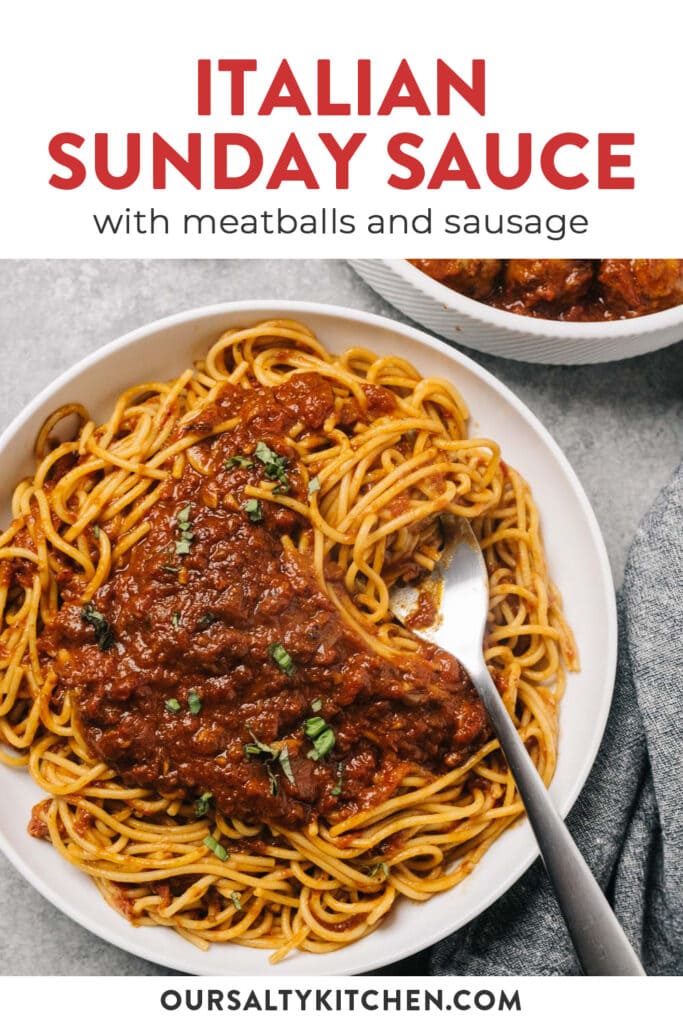

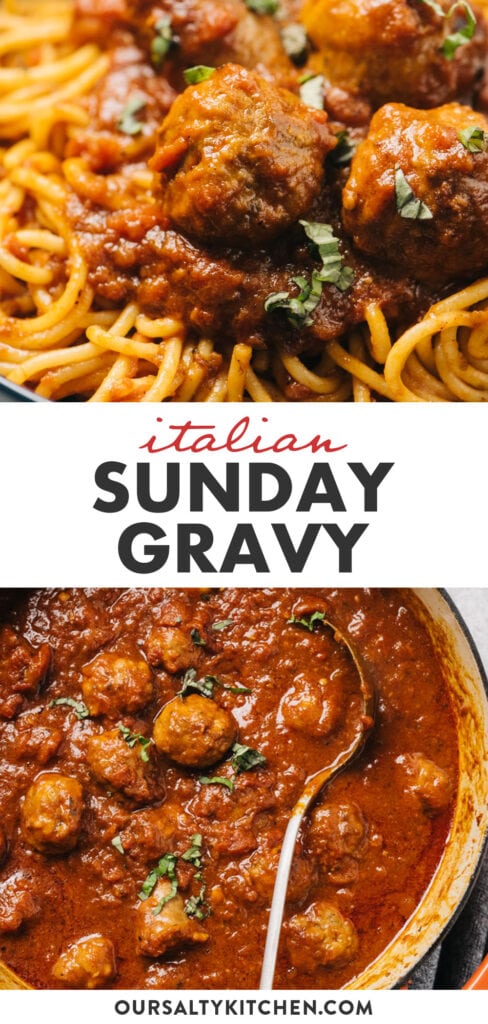
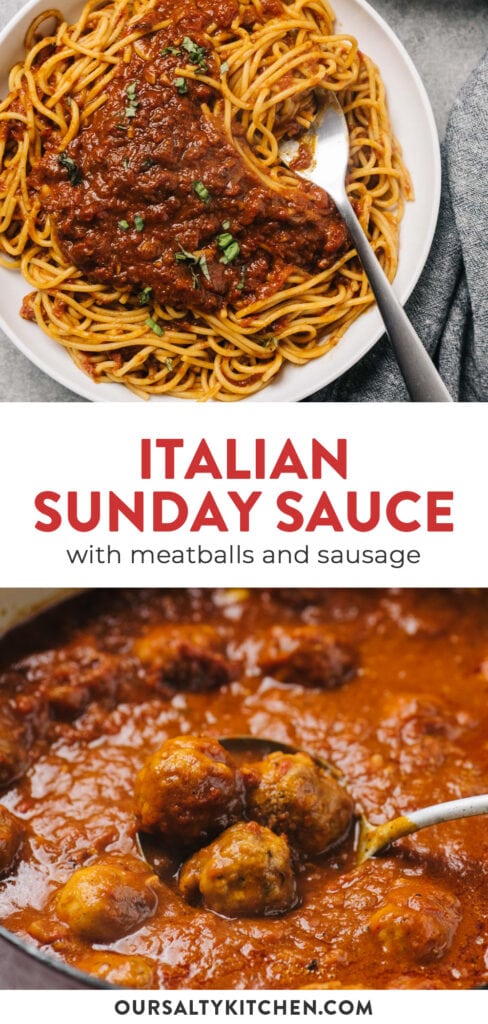
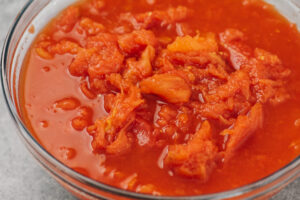
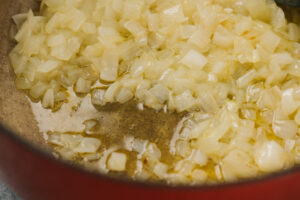

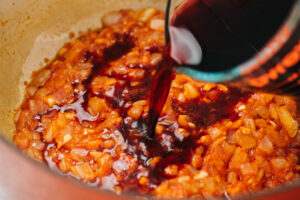
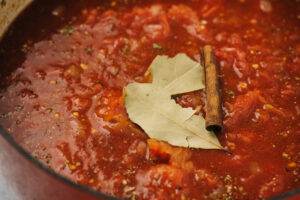
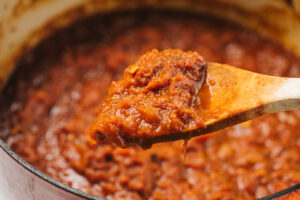
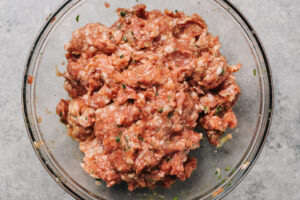
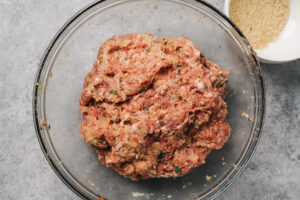

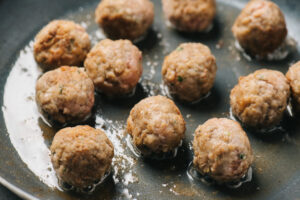
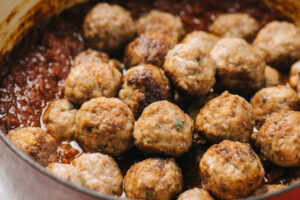

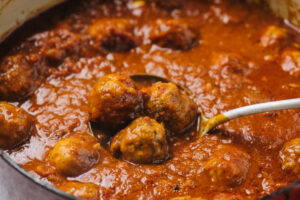
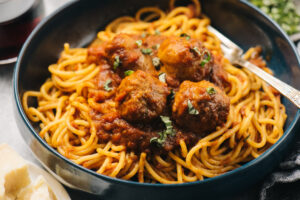

Becca
Do you think that after deglazing with the wine the ingredients could be added to a slow cooker on low for 7-8 hours instead of simmered on the stovetop?
Danielle
You could definitely finish in a slow cooker. I would take off the lid for the last hour and keep partially covered, stirring every 15 minutes or so to crush the tomatoes. This will also help some of the steam escape allowing the sauce thicken to up a bit since the slow cooker retains most of the liquid.
Sheri
I made this last week and it was amazing. I can’t get everything at the store right now (due to covid-19) and it was between shops, so I did have to substitute dry herbs for fresh and ground cinnamon for a stick, but it still came out great. The meatballs are the best I’ve ever made. I’m looking forward to when I can get all the ingredients I need so I can make the recipe as written.
KenPDX
Danielle, you have made my day! And exceeded expectations. Firstly, I came just looking for hints that might apply to improve my own “gravy” non-recipe, and possibly up my game. Got that! Then I learned the exact differences between Marinara and Pomodoro, etc.etc. Cool! But mostly I want to comment on your writing style. If you ever decide to give up your food blogging gig, I swear you could do very well as a full-time writer in some other genre. I nearly spit coffee out my nose several times, your style is so conversational and hilarious. (“Go ahead, break my heart.”) Spot-on rendering of somebody’s Nonna. Keep up the good work; I subscribed and I want more!
Danielle Esposti
Well, I think two days have been made. Thank you for such a thoughtful comment, Ken, and I hope you’re well on your way to creating your family’s perfect Sunday Sauce! Hope you enjoy our content. Have a great week!